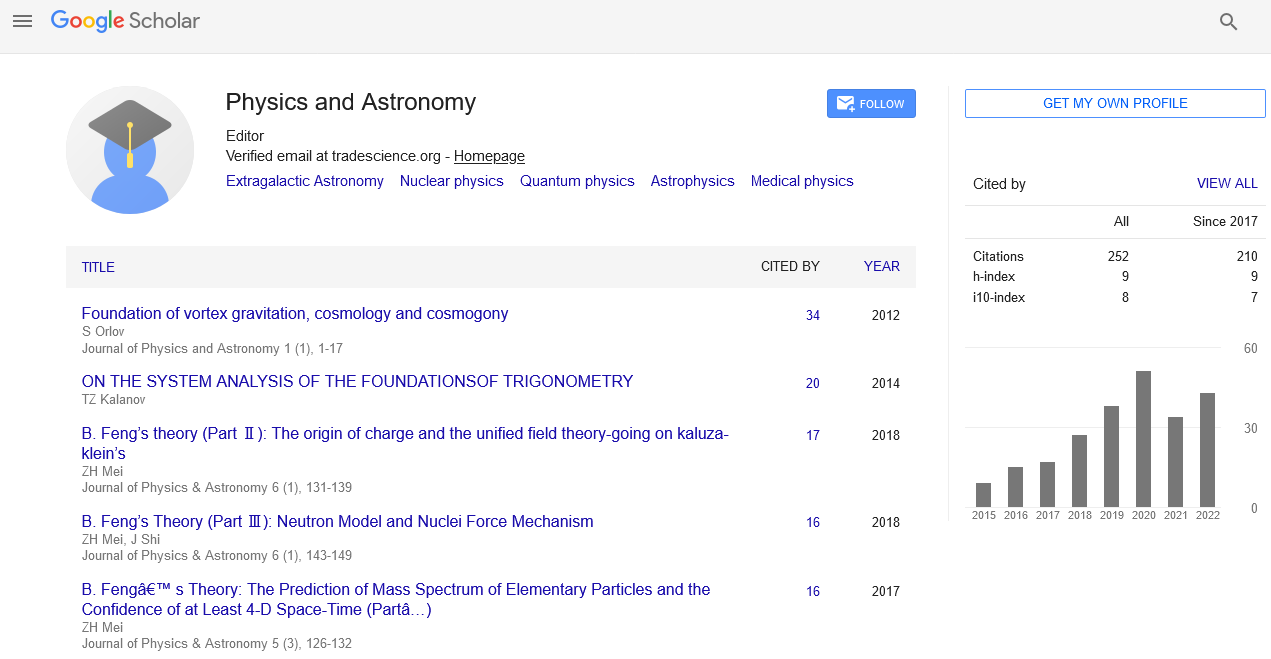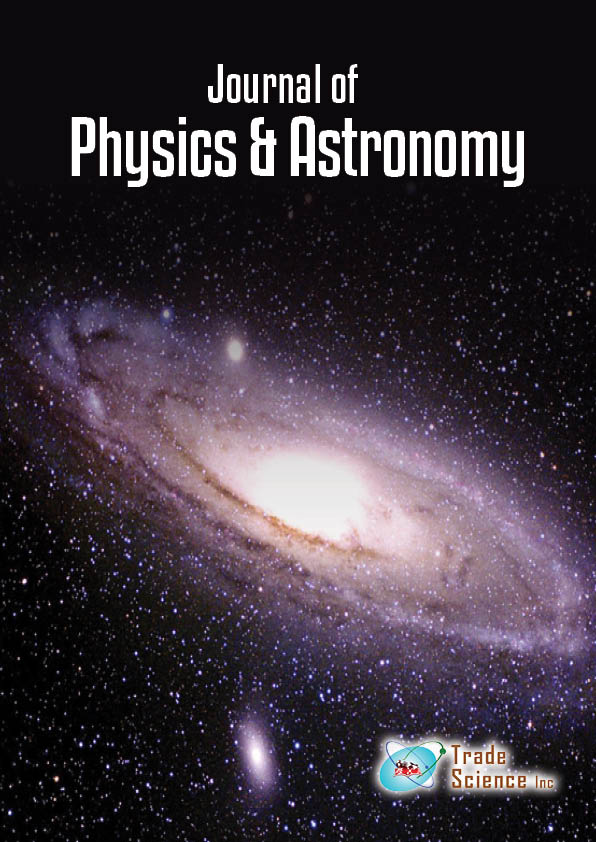Perspective
, Volume: 12( 11)The Holographic Principle as the Origin of Spacetime Invariance
- *Correspondence:
- Bhushan PoojaryDepartment of Physics, NIIMS University, Jaipur, India, E-mail: bhushanpoojary@gmail.com
Received date: Oct-27-2024, Manuscript No tspa-24-155171; Editor assigned: Nov-01-2024, Pre-QC No. tspa-24-155171(PQ); Reviewed: Nov-04-2024, QC No. tspa-24-155171(Q); Revised: Nov-08-2024, Manuscript No. tspa-24-155171(R); Published: Nov-22-2024, DOI. 10.37532/2320-6756.2024.12(12).347
Citation: Poojary B. The Holographic Principle as the Origin of Spacetime Invariance. J Phys Astron. 2024;12(12):347.
Abstract
This paper explores the connection between the holographic principle and the invariance of spacetime intervals, proposing that the matter and anti-matter "address" in a holographic plane governs the perceived constancy of the speed of light and Lorentz invariance. We extend this framework to unify insights from quantum mechanics, special relativity, and the holographic principle. By proposing that photons are "stuck" in the holographic plane, we explain the emergence of spacetime invariance, investigate the role of entanglement entropy, and provide a mathematical basis for linking holography to Minkowski spacetime. The paper also discusses implications for quantum gravity and outlines testable predictions for validating this framework.
Keywords
Spacetime; Quantum mechanics; Holographic planes
Introduction
Einstein’s postulates for special relativity established the constancy of the speed of light and the invariance of physical laws across inertial reference frames [1]. While these principles are foundational, their deeper origins remain unclear. This paper addresses these origins by leveraging the holographic principle, suggesting that spacetime invariance emerges from the encoding of physical information in a lower-dimensional holographic plane [2, 3].
The hypothesis builds on two core ideas:
• The matter and anti-matter "address" is dynamically encoded in the holographic plane, moving at the speed of light.
• Photons remain "stuck" in this plane, resulting in the perception of spacetime invariance by matter.
We further explore connections to quantum field theory, spacetime intervals, and the implications of this framework for quantum gravity.
Physical Interpretation of the Holographic Plane
What is the holographic plane?
The holographic plane is posited as a two-dimensional information surface encoding the positions and states of particles in a lowerdimensional framework. This idea is inspired by the AdS/CFT correspondence, but extends beyond anti-de Sitter spaces to apply universally to Minkowski spacetime [4].
• Matter and anti matter address: The electron's position is encoded as an "address" on this holographic plane, moving at the speed of light.
• Photon's role: Photons are constrained within the plane, representing interactions and projections between matter encoded in 4D spacetime.
Observable implications
The holographic framework offers intuitive explanations for observed phenomena:
• The constant speed of light arises because matter always perceives the projection of light's address at c [1].
• The invariance of spacetime intervals is a consequence of the holographic plane's geometric constraints [3, 5].
Mathematical Framework
Holographic encoding and lorentz invariance
The holographic plane is mathematically represented as a lower-dimensional surface with coordinates (u,v), mapping to 4D spacetime (t,x,y,z) via projection operators P:(u,v)→(t,x,y,z) [5].
The spacetime interval s2 = c2 t 2 - x2 – y2 – z2 remains invariant because the holographic plane enforces the conservation of an equivalent interval σ2.

where σ2 corresponds to the "holographic interval."
Using Lorentz transformations (u′,v′), we derive their Minkowski counterparts in spacetime [1, 6]:

The invariance of σ2 guarantees that s2 is also invariant, linking holographic dynamics to Lorentz invariance.
Photons in the holographic plane
Photons are described by null intervals in the holographic plane (σ2 =0), analogous to light like intervals in spacetime (s2 = 0) [7]:
 photon’s "motion" is confined to the plane.
photon’s "motion" is confined to the plane.
Entanglement entropy
We hypothesize that the matter and anti matter address is tied to entanglement entropy on the holographic plane. The entropy S of a system corresponds to the area A of its projection:

Implications for Quantum Field Theory
The holographic principle provides a global encoding of local interactions, unifying particle-field duality with spacetime invariance.
• Locality and causality: The projection P ensures that local interactions in spacetime correspond to encoded dynamics on the holographic plane [4].
• Photon's role in QFT: The "stuck photon" hypothesis aligns with gauge invariance, where photons mediate interactions without violating spacetime symmetries [7].
Implications for Quantum Gravity
• Emergent spacetime: The holographic perspective aligns with theories where spacetime is emergent from quantum entanglement [8].
• AdS/CFT generalization: While inspired by AdS/CFT, this framework applies to flat spacetime, suggesting a broader principle underlying spacetime structure [4].
• Black hole physics: The invariance of s2 parallels the invariance of entropy across black hole horizons, linking holographic principles to gravitational dynamics [9].
Experimental Predictions
• Deviations at small scales: Test for deviations from Lorentz invariance at Planck-scale energies, where holographic effects might become significant [6].
• Cosmological observations: Investigate the holographic encoding of the cosmic microwave background for signs of lowerdimensional projections [8].
• Entanglement experiments: Test whether changes in entanglement entropy correspond to shifts in particle "addresses" on the holographic plane [4].
Conclusion
This paper proposes that spacetime invariance arises from the holographic principle, with matter and photons encoded in a lowerdimensional plane. By providing a mathematical framework and connecting holography to Lorentz invariance, we offer a novel perspective on spacetime's structure. Future work will explore deeper connections to quantum gravity and testable predictions.
References
- Einstein A. On the electrodynamics of moving bodies. 1905.
- Maldacena J. The large-N limit of superconformal field theories and supergravity. Int J Theor Phys. 1999;38(4):1113-33.
- Minkowski H. Space and Time: Minkowski's papers on relativity. Minkowski Inst Press. 2013.
- Susskind L. The world as a hologram. J Math Phys. 1995;36(11):6377-96.
- Lorentz HA. Electromagnetic phenomena in a system moving with any velocity smaller than that of light. Dordr: Springer Neth. 1937:172-97.
- Witten E. Anti de Sitter space and holography. 1998.
- Zee A. Quantum field theory in a nutshell. Princet Univ Press. 2010.
- Bekenstein JD. Black holes and entropy. Phys Rev D. 1973;7(8):2333.
- Hawking SW. Particle creation by black holes. Commun Math Phys. 1975;43(3):199-220.

